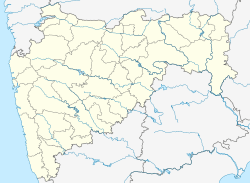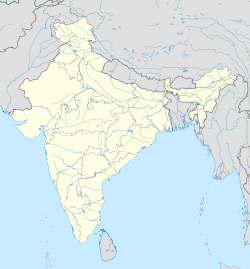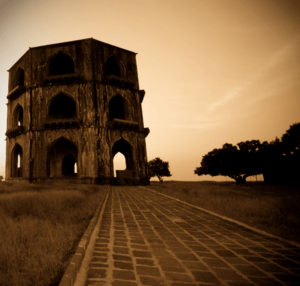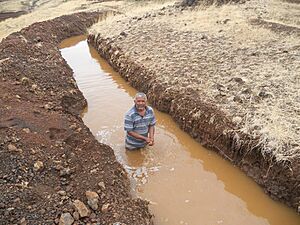Ahmednagar facts for kids
Quick facts for kids
Ahmednagar
|
|
|---|---|
|
City
|
|
| Ahilya Nagar | |
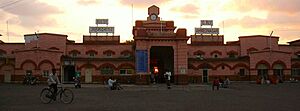
Ahmednagar railway station
|
|
| Country | India |
| State | Maharashtra |
| District | Ahmednagar |
| Division | Nashik |
| Founded | 1490 |
| Founded by | Ahmad Nizam Shah I |
| Named for | Ahmad Nizam Shah I (formerly) Ahilyadevi Holkar (present) |
| Government | |
| • Type | Mayor–Council |
| • Body | Ahmednagar Municipal Corporation |
| Area | |
| • Total | 39.30 km2 (15.17 sq mi) |
| Elevation | 649 m (2,129 ft) |
| Population
(2011)
|
|
| • Total | 350,905 |
| • Rank | 124th |
| • Density | 8,928.9/km2 (23,125.7/sq mi) |
| Demonym(s) | AhilyaNagari / Ahilyanagarkar / Ahmednagarkar / Ahmednagari /Nagarkar (Marathi) |
| Languages | |
| • Official | Marathi |
| Time zone | UTC+5:30 (IST) |
| PIN |
414001, 414003
|
| Telephone code | 0241 |
| Vehicle registration | MH-16, MH-17 |
Ahmednagar, now officially called Ahilya Nagar, is an important city in the Maharashtra state of India. It's the main city of the Ahmednagar district. The city is about 120 kilometers (75 miles) northeast of Pune and 114 kilometers (71 miles) from Aurangabad.
Ahmednagar has many old buildings and sites from the Nizam Shahi period. The Ahmednagar Fort was once thought to be impossible to capture. The British used it to hold important Indian leaders like Jawaharlal Nehru, who became India's first prime minister. He even wrote his famous book The Discovery of India while he was kept there in 1944. Some rooms in the fort are now a museum.
The city is also home to several important military training centers for the Indian Army. These include the Indian Armoured Corps Centre & School (ACC&S) and the Mechanised Infantry Regimental Centre (MIRC). Ahmednagar is a smaller city compared to places like Mumbai and Pune. It is known for its 19 sugar factories and is where the cooperative movement in India began. Because it doesn't get much rain, the city sometimes faces droughts. Most people in Ahmednagar speak Marathi. The city government has plans to develop the city by the year 2031.
Contents
Why the City is Called Ahilya Nagar
Ahmednagar was named after Ahmad Nizam Shah I. He founded the city in 1494 after winning an important battle. The city was built near a village called Bhingar. When the old Bahmani Sultanate broke apart, Ahmad started his own kingdom in Ahmednagar, known as the Nizam Shahi dynasty.
In May 2023, the Chief Minister of Maharashtra, Eknath Shinde, announced that Ahmednagar would be renamed "Ahilya Nagar". This was done to honor Ahilyabai Holkar. She was a queen of Indore in the late 1700s and was known for her wisdom and good rule. The state government officially approved the renaming in March 2024.
History of Ahilya Nagar
The city of Ahmednagar was started in 1494 by Ahmad Nizam Shah I. It was built on the site of an older city called Bhingar. Ahmad created a new kingdom here, called the Nizam Shahi dynasty.
This kingdom was one of the Deccan sultanates. It lasted until 1636 when the Mughal emperor Shah Jahan conquered it. Later, Aurangzeb, the last great Mughal emperor, spent his final years in the Deccan region. He died in Ahmednagar in 1707 and is buried nearby in Khuldabad.
In 1759, the Peshwa (a leader of the Marathas) took control of Ahmednagar. Later, in 1795, it was given to the Maratha chief Daulat Rao Sindhia. In 1803, a British army led by Richard Wellesley attacked and captured Ahmednagar. It was given back to the Marathas but then came under British control again in 1817, after a peace agreement called the Treaty of Poona. At that time, it was known as Ahmednuggur.
In the 1800s, American Christian missionaries started some of the first modern schools in Ahmednagar. Cynthia Farrar ran four girls' schools around the 1850s. Mahatma Jyotirao Phule, a famous social reformer, was inspired by these schools. He then opened schools for girls in Pune and even sent his wife, Savitribai Phule, to Farrar's school to train as a teacher. Cynthia Farrar spent her life in Ahmednagar, running these important schools for girls.
Military Base
Ahmednagar is a very important place for the Indian Army. It is home to:
- The Indian Armored Corps Centre & School (ACC&S), where soldiers are trained for armored vehicles like tanks.
- The Mechanized Infantry Regimental Centre (MIRC).
- The Vehicle Research and Development Establishment (VRDE).
- The Controllerate of Quality Assurance Vehicles (CQAV).
Training and recruitment for the Indian Army Armored Corps happen at the ACC&S.
In the past, the city was a base for the British Army's Royal Tank Corps. Ahmednagar has the second-largest collection of military tanks in the world, and the largest in Asia.
Geography
Climate
Ahmednagar is located in a "rain shadow" area of the Western Ghats mountains. This means it gets much less rain than other places in Maharashtra. The climate is hot for most of the year. It gets very hot from March to mid-June, just before the monsoon season. During the monsoon, Ahmednagar receives less than a third of the rain that Mumbai gets.
| Climate data for Ahmednagar (1991–2020, extremes 1901–2012) | |||||||||||||
|---|---|---|---|---|---|---|---|---|---|---|---|---|---|
| Month | Jan | Feb | Mar | Apr | May | Jun | Jul | Aug | Sep | Oct | Nov | Dec | Year |
| Record high °C (°F) | 36.1 (97.0) |
38.9 (102.0) |
43.2 (109.8) |
43.5 (110.3) |
44.0 (111.2) |
43.3 (109.9) |
37.7 (99.9) |
39.5 (103.1) |
38.2 (100.8) |
39.7 (103.5) |
35.6 (96.1) |
35.6 (96.1) |
44.0 (111.2) |
| Mean daily maximum °C (°F) | 30.5 (86.9) |
32.7 (90.9) |
36.4 (97.5) |
38.8 (101.8) |
38.7 (101.7) |
33.3 (91.9) |
29.6 (85.3) |
29.2 (84.6) |
29.8 (85.6) |
32.1 (89.8) |
31.1 (88.0) |
30.7 (87.3) |
32.8 (91.0) |
| Mean daily minimum °C (°F) | 11.1 (52.0) |
12.9 (55.2) |
16.4 (61.5) |
20.5 (68.9) |
22.4 (72.3) |
22.5 (72.5) |
21.6 (70.9) |
20.7 (69.3) |
20.6 (69.1) |
18.5 (65.3) |
15.1 (59.2) |
11.0 (51.8) |
17.9 (64.2) |
| Record low °C (°F) | 1.8 (35.2) |
2.8 (37.0) |
7.5 (45.5) |
9.5 (49.1) |
15.2 (59.4) |
17.0 (62.6) |
16.5 (61.7) |
12.2 (54.0) |
10.7 (51.3) |
10.6 (51.1) |
5.6 (42.1) |
3.3 (37.9) |
1.8 (35.2) |
| Average rainfall mm (inches) | 0.3 (0.01) |
0.6 (0.02) |
1.6 (0.06) |
4.8 (0.19) |
19.3 (0.76) |
135.7 (5.34) |
93.5 (3.68) |
116.5 (4.59) |
153.5 (6.04) |
65.5 (2.58) |
14.2 (0.56) |
2.6 (0.10) |
608.1 (23.94) |
| Average rainy days | 0.0 | 0.1 | 0.4 | 0.6 | 1.1 | 6.7 | 6.1 | 5.5 | 7.7 | 3.5 | 0.7 | 0.1 | 32.5 |
| Average relative humidity (%) (at 17:30 IST) | 36 | 30 | 25 | 24 | 28 | 56 | 67 | 69 | 68 | 58 | 51 | 44 | 46 |
| Source: India Meteorological Department | |||||||||||||
People of Ahilya Nagar
| Religions in Ahmednagar city (2011) | ||||
|---|---|---|---|---|
| Religion | Percent | |||
| Hinduism | 75.69% | |||
| Islam | 15.64% | |||
| Jainism | 4.35% | |||
| Christianity | 2.57% | |||
| Buddhism | 0.85% | |||
| Other or not stated | 0.90% | |||
In 2011, Ahmednagar had a population of about 350,859 people. For every 1000 boys, there were 961 girls. About 84% of the people could read and write, which is higher than the average for cities in India. About 10% of the population was under 6 years old.
According to the 2011 Census, most people in Ahmednagar (68.01%) speak Marathi as their first language. Other languages spoken include Hindi (9.43%), Urdu (8.59%), Telugu (4.86%), Marwari (4.31%), Sindhi (1.35%), and Gujarati (0.95%).
Famous People from Ahilya Nagar
Many notable people have connections to Ahmednagar:
- Malik Ambar – A military leader known for fighting against the Mughal Empire.
- Sadashiv Amrapurkar – A well-known film and theater actor.
- Rajanikant Arole – A doctor who won the Magsaysay Award and Padma Bhushan for his social work.
- Meher Baba – A spiritual leader.
- Chand Bibi – A brave princess who defended Ahmednagar Fort against the Mughal army.
- Anna Hazare – A famous social activist who follows the ideas of Mahatma Gandhi.
- Zaheer Khan – A well-known cricketer.
- Spike Milligan – A famous comedian and author from the UK, who was born here.
- Ajinkya Rahane – A well-known cricketer.
- Sai Baba of Shirdi – A spiritual master.
Places to Visit in Ahilya Nagar
There are many interesting places to visit in and around Ahmednagar:
- Tomb of Salabat Khan II – This impressive three-story stone building is also called the Chand Bibi Palace. It's located on top of a hill about 13 km (8 miles) from the city.
- Meherabad – This is a holy place where the samadhi (tomb) of the spiritual master Meher Baba is located. Many people visit, especially on the anniversary of his death, called Amartithi. His later home was at Meherazad, near Pimpalgaon village.
- Ahmednagar Fort (Bhuekot Killa) – Built by Ahmed Nizam Shah in 1490, this fort is known for its strong design and being very difficult to capture. As of 2013, it is controlled by the Indian military.
- Cavalry Tank Museum – This museum, created by the Armoured Corps Centre and School, has a large collection of armored fighting vehicles from the 20th century.
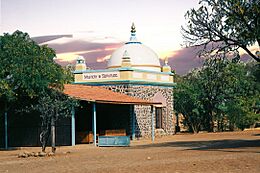
- Ralegan Siddhi – This village is a great example of environmental conservation. The social activist Anna Hazare is from Ralegan Siddhi.
- Pimpri Gawali – This village is about 25 km (15 miles) from Ahmednagar. It is known for its work in water management and farming businesses.
- Shani Shingnapur – A famous temple dedicated to the God Shani.
Getting Around Ahilya Nagar
By Air
Ahmednagar has one airport. The closest domestic airport is in Shirdi, about 90 km (56 miles) away. The nearest international airport is in Pune.
Ahmednagar also has a seaplane service. The seaplane port is at the Mula Dam water reservoir, which is about 30 minutes from the city. This service, started in 2014, connects Ahmednagar to Juhu, Mumbai.
By Rail
Ahmednagar railway station (station code: ANG) is part of the Solapur Division of the Central Railway zone. Ahmednagar has train connections to major cities like Pune, Manmad, Shirdi, Mumbai, Chennai, Kolkata, and Bangalore. About 41 express trains stop at this station.
Ahmednagar station will soon be part of the Pune railway division. This change might lead to more local train services between Ahmednagar and Pune. There are also plans for new railway lines, including a survey for an Ahmednagar-Aurangabad line and exploration of an Ahmednagar-Karmala line.
By Road
Ahmednagar is well connected by roads to major cities in Maharashtra and other states. It has four-lane road connections to places like Chhatrapati Sambhajinagar, Pune, Nashik, and Solapur.
The Maharashtra State Road Transport Corporation (MSRTC) and private bus companies offer bus services connecting Ahmednagar to all parts of the state.
Ahmednagar has three main bus stands:
- MSRTC Tarakpur Bus Stand – All buses passing through Ahmednagar stop here.
- Maliwada Bus Stand – Buses going to Aurangabad or Jalgaon stop here.
- Pune Bus Stand – Buses going to Pune or Mumbai stop here.
Getting Around the City
- Autorickshaws are a common way to travel within the city. You can also find shared autorickshaws.
- The Municipal Corporation also runs a bus service with several routes connecting different parts of the city.
News and Communication
- Newspapers: You can read many newspapers in Ahmednagar, including Lokmat, Sakaal, Pudhari, Sarvamat, Deshdoot, and Loksatta.
- TV Channels: Local TV channels include CMN Channel, News Today 24 Ahmednagar, and ATV Ahmednagar.
- Radio: You can listen to radio stations like 104 MY FM, AIR Nagar FM, Radio City, Dhamaal 24, and Radio Nagar FM.
- Internet: Several companies provide internet services in the city.
See also
 In Spanish: Ahmednagar para niños
In Spanish: Ahmednagar para niños


